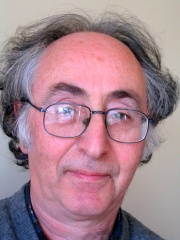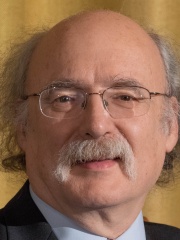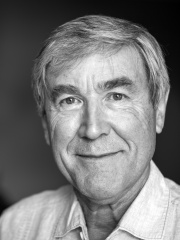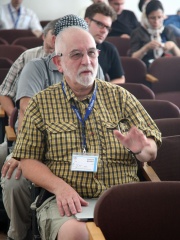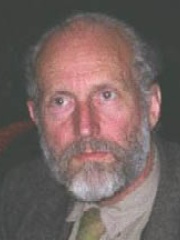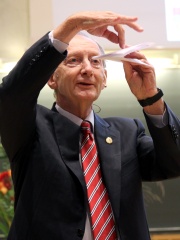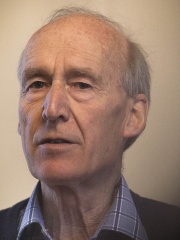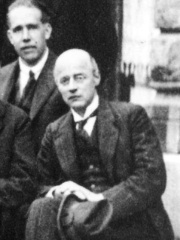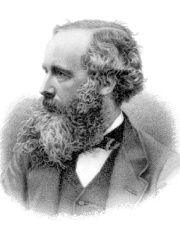
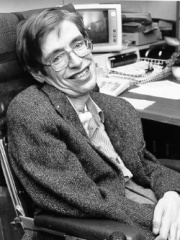



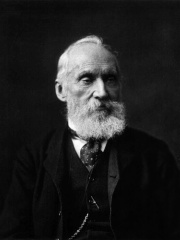

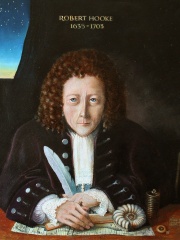
The Most Famous
PHYSICISTS from United Kingdom
This page contains a list of the greatest British Physicists. The pantheon dataset contains 851 Physicists, 91 of which were born in United Kingdom. This makes United Kingdom the birth place of the 3rd most number of Physicists behind United States, and Germany.
Top 10
The following people are considered by Pantheon to be the top 10 most legendary British Physicists of all time. This list of famous British Physicists is sorted by HPI (Historical Popularity Index), a metric that aggregates information on a biography's online popularity. Visit the rankings page to view the entire list of British Physicists.

1. Isaac Newton (1643 - 1726)
With an HPI of 99.44, Isaac Newton is the most famous British Physicist. His biography has been translated into 235 different languages on wikipedia.
Sir Isaac Newton ( ; 4 January [O.S. 25 December] 1643 – 31 March [O.S. 20 March] 1727) was an English polymath who was a mathematician, physicist, astronomer, alchemist, theologian, author and inventor. He was a key figure in the Scientific Revolution and the Enlightenment that followed. His book Philosophiæ Naturalis Principia Mathematica (Mathematical Principles of Natural Philosophy), first published in 1687, achieved the first great unification in physics and established classical mechanics. Newton also made seminal contributions to optics, and shares credit with the German mathematician Gottfried Wilhelm Leibniz for formulating infinitesimal calculus, although he developed calculus years before Leibniz. Newton contributed to and refined the scientific method, and his work is considered the most influential in bringing forth modern science. In the Principia, Newton formulated the laws of motion and universal gravitation that formed the dominant scientific viewpoint for centuries until it was superseded by the theory of relativity. While this is the case, his laws still serve as excellent approximations for the vast majority of physical phenomena involving low speeds (much less than the speed of light) and weak gravitational fields. He used his mathematical description of gravity to derive Kepler's laws of planetary motion, account for tides, the trajectories of comets, the precession of the equinoxes and other phenomena, eradicating doubt about the Solar System's heliocentricity. Newton solved the two-body problem and introduced the three-body problem. He demonstrated that the motion of objects on Earth and celestial bodies could be accounted for by the same principles. Newton's inference that the Earth is an oblate spheroid was later confirmed by the geodetic measurements of Alexis Clairaut, Charles Marie de La Condamine, and others, convincing most European scientists of the superiority of Newtonian mechanics over earlier systems. He was also the first to calculate the age of Earth by experiment, and described a precursor to the modern wind tunnel. Further, he was the first to provide a quantitative estimate of the solar mass. Newton built the first reflecting telescope and developed a sophisticated theory of colour based on the observation that a prism separates white light into the colours of the visible spectrum. His work on light was collected in his book Opticks, published in 1704. He originated prisms as beam expanders and multiple-prism arrays, which would later become integral to the development of tunable lasers. He anticipated the wave–particle duality of light and was first to theorise the Goos–Hänchen effect. He also formulated an empirical law of cooling, which was the first heat transfer formulation and serves as the formal basis of convective heat transfer, made the first theoretical calculation of the speed of sound, and introduced the notions of a Newtonian fluid and a black body. He was also the first to explain the Magnus effect. Moreover, he was the first to analyse Couette flow. In addition to his creation of calculus, Newton's work on mathematics was extensive. He generalised the binomial theorem to any real number, introduced the Puiseux series, was the first to state Bézout's theorem, classified most of the cubic plane curves, contributed to the study of Cremona transformations, developed a method for approximating the roots of a function, originated the Newton–Cotes formulas used for numerical integration, and further produced the earliest explicit enunciation of the general Taylor series. Additionally, Newton initiated the field of calculus of variations, formulated and solved the earliest problem in geometric probability, devised the earliest form of linear regression, and was a pioneer of vector analysis. Newton was a fellow of Trinity College and the second Lucasian Professor of Mathematics at the University of Cambridge; he was appointed at the age of 26. He was a devout but unorthodox Christian who privately rejected the doctrine of the Trinity. He refused to take holy orders in the Church of England, unlike most members of the Cambridge faculty of the day. Beyond his work on the mathematical sciences, Newton dedicated much of his time to the study of alchemy and biblical chronology, but most of his work in those areas remained unpublished until long after his death. Politically and personally tied to the Whigs, Newton served two brief terms as Member of Parliament for the University of Cambridge, in 1689–1690 and 1701–1702. He was knighted by Queen Anne in 1705 and spent the last three decades of his life in London, serving as Warden (1696–1699) and Master (1699–1727) of the Royal Mint, in which he increased the accuracy and security of British coinage. He was also the president of the Royal Society (1703–1727).

2. Stephen Hawking (1942 - 2018)
With an HPI of 88.36, Stephen Hawking is the 2nd most famous British Physicist. His biography has been translated into 151 different languages.
Stephen William Hawking (8 January 1942 – 14 March 2018) was an English theoretical physicist, cosmologist, and author who was director of research at the Centre for Theoretical Cosmology at the University of Cambridge. Between 1979 and 2009, he was the Lucasian Professor of Mathematics at Cambridge, widely viewed as one of the most prestigious academic posts in the world. Hawking was born in Oxford into a family of physicians. In October 1959, at the age of 17, he began his university education at University College, Oxford, where he received a first-class BA degree in physics. In October 1962, he began his graduate work at Trinity Hall, Cambridge, where, in March 1966, he obtained his PhD in applied mathematics and theoretical physics, specialising in general relativity and cosmology. In 1963, at age 21, Hawking was diagnosed with an early-onset slow-progressing form of motor neurone disease that gradually, over decades, paralysed him. After the loss of his speech, he communicated through a speech-generating device, initially through use of a handheld switch, and eventually by using a single cheek muscle. Hawking's scientific works included a collaboration with Roger Penrose on gravitational singularity theorems in the framework of general relativity, and the theoretical prediction that black holes emit radiation, often called Hawking radiation. Initially, Hawking radiation was controversial. By the late 1970s, and following the publication of further research, the discovery was widely accepted as a major breakthrough in theoretical physics. Hawking was the first to set out a theory of cosmology explained by a union of the general theory of relativity and quantum mechanics. Hawking was a vigorous supporter of the many-worlds interpretation of quantum mechanics. He also introduced the notion of a micro black hole. Hawking achieved commercial success with several works of popular science in which he discussed his theories and cosmology in general. His book A Brief History of Time appeared on the Sunday Times bestseller list for a record-breaking 237 weeks. Hawking was a Fellow of the Royal Society, a lifetime member of the Pontifical Academy of Sciences, and a recipient of the Presidential Medal of Freedom, the highest civilian award in the United States. In 2002, Hawking was ranked number 25 in the BBC's poll of the 100 Greatest Britons. He died in 2018 at the age of 76, having lived more than 50 years following his diagnosis of motor neurone disease.

3. Michael Faraday (1791 - 1867)
With an HPI of 86.08, Michael Faraday is the 3rd most famous British Physicist. His biography has been translated into 151 different languages.
Michael Faraday ( FAR-uh-day; 22 September 1791 – 25 August 1867) was an English chemist and physicist who contributed to the study of electrochemistry and electromagnetism. His main discoveries include the principles underlying electromagnetic induction, diamagnetism, and electrolysis. Although Faraday received little formal education, as a self-made man, he was one of the most influential scientists in history. It was by his research on the magnetic field around a conductor carrying a direct current that Faraday established the concept of the electromagnetic field in physics. Faraday also established that magnetism could affect rays of light and that there was an underlying relationship between the two phenomena. He similarly discovered the principles of electromagnetic induction, diamagnetism, and the laws of electrolysis. His inventions of electromagnetic rotary devices formed the foundation of electric motor technology, and it was largely due to his efforts that electricity became practical for use in technology. The SI unit of capacitance, the farad, is named after him. As a chemist, Faraday discovered benzene and carbon tetrachloride, investigated the clathrate hydrate of chlorine, invented an early form of the Bunsen burner and the system of oxidation numbers, and popularised terminology such as "anode", "cathode", "electrode" and "ion". Faraday ultimately became the first and foremost Fullerian Professor of Chemistry at the Royal Institution, a lifetime position. Faraday was an experimentalist who conveyed his ideas in clear and simple language. His mathematical abilities did not extend as far as trigonometry and were limited to the simplest algebra. Physicist and mathematician James Clerk Maxwell took the work of Faraday and others and summarised it in a set of equations which is accepted as the basis of all modern theories of electromagnetic phenomena. On Faraday's uses of lines of force, Maxwell wrote that they show Faraday "to have been in reality a mathematician of a very high order – one from whom the mathematicians of the future may derive valuable and fertile methods." A highly principled scientist, Faraday devoted considerable time and energy to public service. He worked on optimising lighthouses and protecting ships from corrosion. With Charles Lyell, he produced a forensic investigation on a colliery explosion at Haswell, County Durham, indicating for the first time that coal dust contributed to the severity of the explosion, and demonstrating how ventilation could have prevented it. Faraday also investigated industrial pollution at Swansea, air pollution at the Royal Mint, and wrote to The Times on the foul condition of the River Thames during the Great Stink. He refused to work on developing chemical weapons for use in the Crimean War, citing ethical reservations. He declined to have his lectures published, preferring people to recreate the experiments for themselves, to better experience the discovery, and told a publisher: "I have always loved science more than money & because my occupation is almost entirely personal I cannot afford to get rich." Albert Einstein kept a portrait of Faraday on his study wall, alongside those of Isaac Newton and James Clerk Maxwell. Physicist Ernest Rutherford stated, "When we consider the magnitude and extent of his discoveries and their influence on the progress of science and of industry, there is no honour too great to pay to the memory of Faraday, one of the greatest scientific discoverers of all time."

4. J. J. Thomson (1856 - 1940)
With an HPI of 83.98, J. J. Thomson is the 4th most famous British Physicist. His biography has been translated into 107 different languages.
Sir Joseph John Thomson (18 December 1856 – 30 August 1940) was a British physicist whose study of cathode rays led to his discovery of the electron, a subatomic particle with a negative electric charge. In 1897, he showed that cathode rays were composed of previously unknown negatively charged particles (now called electrons), which he calculated must have bodies much smaller than atoms and a very large charge-to-mass ratio. In 1906, Thomson was awarded the Nobel Prize in Physics "in recognition of the great merits of his theoretical and experimental investigations on the conduction of electricity by gases." Thomson is credited with finding the first evidence for isotopes of a stable (non-radioactive) element in 1912, as part of his exploration into the composition of canal rays (positive ions). His experiments to determine the nature of positively charged particles, with Francis William Aston, were the first use of mass spectrometry and led to the development of the mass spectrograph. Thomson was an influential teacher, and seven of his students went on to win Nobel Prizes: Ernest Rutherford (Chemistry 1908), Lawrence Bragg (Physics 1915), Charles Barkla (Physics 1917), Francis Aston (Chemistry 1922), Charles Thomson Rees Wilson (Physics 1927), Owen Richardson (Physics 1928) and Edward Appleton (Physics 1947).
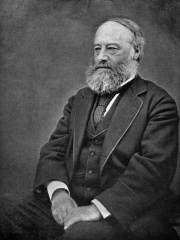
5. James Prescott Joule (1818 - 1889)
With an HPI of 83.91, James Prescott Joule is the 5th most famous British Physicist. His biography has been translated into 119 different languages.
James Prescott Joule (; 24 December 1818 – 11 October 1889) was an English physicist. Joule studied the nature of heat and discovered its relationship to mechanical work. This led to the law of conservation of energy, which in turn led to the development of the first law of thermodynamics. The SI unit of energy, the joule (J), is named after him. He worked with Lord Kelvin to develop an absolute thermodynamic temperature scale, which came to be called the Kelvin scale. Joule also made observations of magnetostriction, and he found the relationship between the current through a resistor and the heat dissipated, which is also called Joule's first law. His experiments about energy transformations were first published in 1843.

6. Edward Victor Appleton (1892 - 1965)
With an HPI of 83.64, Edward Victor Appleton is the 6th most famous British Physicist. His biography has been translated into 81 different languages.
Sir Edward Victor Appleton (6 September 1892 – 21 April 1965) was a British physicist who received the Nobel Prize in Physics in 1947 for his contributions to the knowledge of the ionosphere, which led to the development of radar.

7. William Thomson, 1st Baron Kelvin (1824 - 1907)
With an HPI of 83.39, William Thomson, 1st Baron Kelvin is the 7th most famous British Physicist. His biography has been translated into 85 different languages.
William Thomson, 1st Baron Kelvin (26 June 1824 – 17 December 1907), was a British mathematician, mathematical physicist and engineer. Born in Belfast, he was for 53 years the professor of Natural Philosophy at the University of Glasgow, where he undertook significant research on the mathematical analysis of electricity, was instrumental in the formulation of the first and second laws of thermodynamics, and contributed significantly to unifying physics, which was then in its infancy of development as an emerging academic discipline. He received the Royal Society's Copley Medal in 1883 and served as its president from 1890 to 1895. In 1892 he became the first scientist to be elevated to the House of Lords. Absolute temperatures are stated in units of kelvin in Lord Kelvin's honour. While the existence of a coldest possible temperature, absolute zero, was known before his work, Kelvin determined its correct value as approximately −273.15 degrees Celsius or −459.67 degrees Fahrenheit. The Joule–Thomson effect is also named in his honour. Kelvin worked closely with the mathematics professor Hugh Blackburn in his work. He also had a career as an electrical telegraph engineer and inventor which propelled him into the public eye and earned him wealth, fame and honours. For his work on the transatlantic telegraph project, he was knighted in 1866 by Queen Victoria, becoming Sir William Thomson. He had extensive maritime interests and worked on the mariner's compass, which previously had limited reliability. Kelvin was ennobled in 1892 in recognition of his achievements in thermodynamics, and of his opposition to Irish Home Rule, becoming Baron Kelvin, of Largs in the County of Ayr. The title refers to the River Kelvin, which flows near his laboratory at the University of Glasgow's Gilmorehill home at Hillhead. Despite offers of elevated posts from several world-renowned universities, Kelvin refused to leave Glasgow, remaining until his retirement from that post in 1899. Active in industrial research and development, he was recruited around 1899 by George Eastman to serve as vice-chairman of the board of the British company Kodak Limited, affiliated with Eastman Kodak. In 1904 he became Chancellor of the University of Glasgow. Kelvin resided in Netherhall, a mansion in Largs, which he built in the 1870s and where he died in 1907. The Hunterian Museum at the University of Glasgow has a permanent exhibition on the work of Kelvin, which includes many of his original papers, instruments, and other artefacts, including his smoking-pipe.

8. John William Strutt, 3rd Baron Rayleigh (1842 - 1919)
With an HPI of 83.12, John William Strutt, 3rd Baron Rayleigh is the 8th most famous British Physicist. His biography has been translated into 90 different languages.
John William Strutt, 3rd Baron Rayleigh ( RAY-lee; 12 November 1842 – 30 June 1919), was a British physicist and hereditary peer who received the Nobel Prize in Physics in 1904 for his discovery of argon. Rayleigh provided the first theoretical treatment of the elastic scattering of light by particles much smaller than the light's wavelength, a phenomenon now known as Rayleigh scattering, which notably explains why the sky is blue. He studied and described transverse surface waves in solids, now known as Rayleigh waves. He contributed extensively to fluid dynamics, with concepts such as the Rayleigh number (a dimensionless number associated with natural convection), Rayleigh flow, the Rayleigh–Taylor instability, and Rayleigh's criterion for the stability of Taylor–Couette flow. Rayleigh also formulated the circulation theory of aerodynamic lift. In optics, he proposed a well-known criterion for angular resolution. His derivation of the Rayleigh–Jeans law for classical black-body radiation later played an important role in the birth of quantum mechanics (see ultraviolet catastrophe). His textbook, The Theory of Sound (1877), is still used today by acousticians and engineers. He introduced the Rayleigh test for circular non-uniformity, which the Rayleigh plot visualises. Rayleigh served as President of the Royal Society from 1905 to 1908, and as Chancellor of the University of Cambridge from 1908 until his death in 1919.

9. Robert Hooke (1635 - 1703)
With an HPI of 82.93, Robert Hooke is the 9th most famous British Physicist. His biography has been translated into 95 different languages.
Robert Hooke (; 18 July 1635 – 3 March 1703) was an English polymath who was active as a physicist ('natural philosopher'), astronomer, geologist, meteorologist, and architect. He is credited as one of the first scientists to investigate living things at microscopic scale in 1665, using a compound microscope that he designed. Hooke was an impoverished scientific inquirer in young adulthood who went on to become one of the most important scientists of his time. After the Great Fire of London in 1666, Hooke (as a surveyor and architect) attained wealth and esteem by performing more than half of the property line surveys and assisting with the city's rapid reconstruction. Often vilified by writers in the centuries after his death, his reputation was restored at the end of the twentieth century and he has been called "England's Leonardo [da Vinci]". Hooke was a Fellow of the Royal Society and from 1662, he was its first Curator of Experiments. From 1665 to 1703, he was also Professor of Geometry at Gresham College. Hooke began his scientific career as an assistant to the physical scientist Robert Boyle. Hooke built the vacuum pumps that were used in Boyle's experiments on gas law and also conducted experiments. In 1664, Hooke identified the rotations of Mars and Jupiter. Hooke's 1665 book Micrographia, in which he coined the term cell, encouraged microscopic investigations. Investigating optics – specifically light refraction – Hooke inferred a wave theory of light. His is the first-recorded hypothesis of the cause of the expansion of matter by heat, of air's composition by small particles in constant motion that thus generate its pressure, and of heat as energy. In physics, Hooke inferred that gravity obeys an inverse square law and arguably was the first to hypothesise such a relation in planetary motion, a principle Isaac Newton furthered and formalised in Newton's law of universal gravitation. Priority over this insight contributed to the rivalry between Hooke and Newton. In geology and palaeontology, Hooke originated the theory of a terraqueous globe, thus disputing the Biblical view of the Earth's age; he also hypothesised the extinction of species, and argued hills and mountains had become elevated by geological processes. By identifying fossils of extinct species, Hooke presaged the theory of biological evolution.
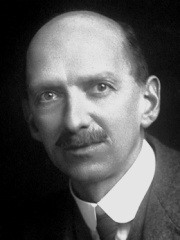
10. Charles Thomson Rees Wilson (1869 - 1959)
With an HPI of 82.58, Charles Thomson Rees Wilson is the 10th most famous British Physicist. His biography has been translated into 87 different languages.
Charles Thomson Rees Wilson (14 February 1869 – 15 November 1959) was a British meteorologist and physicist who shared the 1927 Nobel Prize in Physics with Arthur Compton for his invention of the cloud chamber.
People
Pantheon has 91 people classified as British physicists born between 1544 and 1988. Of these 91, 13 (14.29%) of them are still alive today. The most famous living British physicists include Brian Josephson, Roger Penrose, and Anthony James Leggett. The most famous deceased British physicists include Isaac Newton, Stephen Hawking, and Michael Faraday.
Living British Physicists
Go to all RankingsBrian Josephson
1940 - Present
HPI: 79.14
Roger Penrose
1931 - Present
HPI: 74.08
Anthony James Leggett
1938 - Present
HPI: 69.13
Duncan Haldane
1951 - Present
HPI: 64.83
Paul Davies
1946 - Present
HPI: 59.47
Michael Berry
1941 - Present
HPI: 57.74
Michael Green
1946 - Present
HPI: 56.05
Brandon Carter
1942 - Present
HPI: 55.83
John Pendry
1943 - Present
HPI: 53.06
Brian Cox
1968 - Present
HPI: 53.01
Julian Barbour
1937 - Present
HPI: 52.48
Jeffrey Goldstone
1933 - Present
HPI: 51.47
Deceased British Physicists
Go to all RankingsIsaac Newton
1643 - 1726
HPI: 99.44
Stephen Hawking
1942 - 2018
HPI: 88.36
Michael Faraday
1791 - 1867
HPI: 86.08
J. J. Thomson
1856 - 1940
HPI: 83.98
James Prescott Joule
1818 - 1889
HPI: 83.91
Edward Victor Appleton
1892 - 1965
HPI: 83.64
William Thomson, 1st Baron Kelvin
1824 - 1907
HPI: 83.39
John William Strutt, 3rd Baron Rayleigh
1842 - 1919
HPI: 83.12
Robert Hooke
1635 - 1703
HPI: 82.93
Charles Thomson Rees Wilson
1869 - 1959
HPI: 82.58
Owen Willans Richardson
1879 - 1959
HPI: 82.49
James Clerk Maxwell
1831 - 1879
HPI: 82.02
Overlapping Lives
Which Physicists were alive at the same time? This visualization shows the lifespans of the 25 most globally memorable Physicists since 1700.

